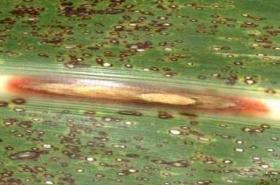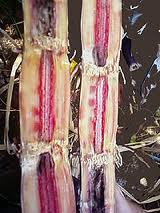Redrot of Sugarcane Host: Saccharum
officinarum Systematic
Position
Pathogen: C.falcatum Division:Eumycota
Sub-division:Deuteromycotina
Class:Hyphomycetes
Order:Melanconiales
Family:Melanconiaceae
Genus:Colletotricum
Species:falcatum
Introduction
This is one of the most serious and important disease occurs in major
sugarcane growing areas of the world leading to common epidemics. In India, it
caused severs loss during 1939-42 and in Bihar
and U.P remains endemic since then. This causes heavy
loss to both cultivators and millers.
Symptoms
·
Discoloration of leaves.
·
Leaf
margins and tips wither and finally droop.
·
Symptoms
can be seen after rainy season when plant growth stops and sucrose formation begins.
·
Dark lesions are formed in the middle portion of
old leaves later turns to blood red
with dark margins.
·
Internodal region shrivels, sinks and becomes
longitudinally wrinkled.
·
Infected
cane split open longitudinally, the central
tissue is found reddened with white patches.
·
The
juice of the cane gives bad odour due to the conversion of sucrose into glucose and
alcohol.
Casual Organism: The fungus C.falcatum
causes Redrot disease disease of sugarcane.
Fungal Structure
The mycelium grows inter (or) intracellular
with hyphae usually thin,septate,hyaline and profusely branched. In between the
setae single celled conidiophores are formed producing conidia usually single
celled, thin walled, colourless, sickle shaped with a large oil globule.
Disease Cycle
The primary infection tales place through setts and soil. The fungus
from the soil enters the healthy setts through cut ends leading to secondary infection. Secondary
infection takes place through water, wind and agricultural implements.  
Infected Leaf & Infected Stem
Favorable Conditions
·
High
relative humidity i.e., 90%
·
Optimum
temp., i.e., 18-25⁰c.
·
Water
logged conditions.
Control measures
·
Using
of disease resistant varieties.
·
Changing
the crop frequently.
·
Field
sanitation.
·
Using
of fungicides : Benomyl Topsin/Aretax nad Bordeaux mixture.
| 




